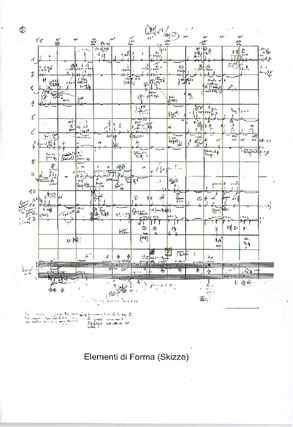
The work was composed expressly for Francesco
Dillon. In the electronics part of the work over four hundred sound samples
played by Dillon have been processed, using almost exclusively a special
device for stringed instruments. This device was designed by
Mario Bertoncini in 1992 and patented by him the following year under
the name STABDÄMPFER (bar sordino). The samples were recorded at
the electroacoustic laboratory of the
Akademie der Künste in Berlin.
Apparently for a singular dialectic inversion, but in reality as the result
of the explicit wish of the composer to exercise complete control of the
performance, the work - on hearing it - is ascribable to the "Informal",
given the microtonal harmonic substance and the absence of clearly identifiable
rhythmic figures. An in-depth analysis of the work reveals, instead, a
complex serial structure that combines the magic square of Jove matrix
with the matrix comprising the first six figures of the Fibonacci sequence.
As this sequence is derived by proportional affinity with the numerical
ratios of the golden section and the duration of the work is represented
by the sum total of the figures of the square of Jove, fragmented in its
turn by a canonic structure which also includes alternate moments of rest,
the composer has consequently organized, according to the proportions
of the golden section, also the reciprocal relationship between live instrumental
sections and pre-recorded material sections.
But this is not all. Halfway through the piece, canonic forms can be found
between live instrument and recorded material as well as the use of palindromic
and canonic structures which accompany the work right up to the end. In
addition, to keep the record straight, it should be added that at matrix
level a third dimension, represented by the organization of the letters
making up the name BACH, transposed and organized in three sections for
a total of twelve different sounds, completes dialectically a yet further
stylistic refutation of the informal content of the piece, which nevertheless
remains undeniable.
With regard to the relevance of the use of dodecaphonic/serial structures,
allow me to recall at this point that if it is true that the entire work
makes use of a microtonal harmonic fabric - that is, based on untempered
intervals - it is equally true that our perception as western musicians
never succeeds in reaching an absolute valuation per se of thirds of a
tone and quarter tones: for the western musician, a quarter tone below
or above a given frequency always presupposes the reference to a known
quantity, the tempered interval.
For the digital processing of the recorded part, I have used exclusively
(as I have already mentioned) the concrete sound of the bar sordino no.
1 without any recourse whatsoever to midi or synthetic processes. The
work, with brief interruptions, was carried out almost daily from December
2000 to June 2001 at a private laboratory (of composer Christian Messer).